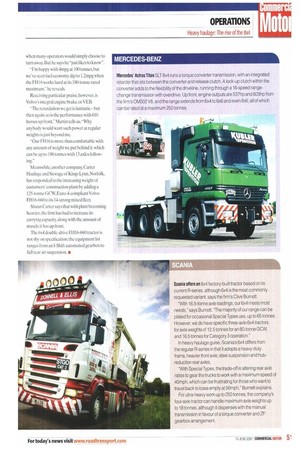SCAN1A
Page 51

If you've noticed an error in this article please click here to report it so we can fix it.
Scan ia offers an 8x4 factory-built tractor based on its current R-series, although 6x4 is the most commonly requested variant, says the firm's Clive Burnett.
"With 16.5-tonne axle loadings, our 6x4 meets most needs," says Burnett. The majority of our range can be plated for occasional Special Types use, up to 65 tonnes. However, we do have specific three-axle 6x4 tractors for axle weights of 12.5 tonnes for an 80-tonne GCW, and 16.5 tonnes for Category 3 operation."
In heavy haulage guise, Scania's 6x4 differs from the regular R-series in that it adopts a heavy-duty frame, heavier front axle, steel suspension and hubreduction rear axles.
"With Special Types, the trade-off is altering rear axle ratios to gear the trucks to work with a maximum speed of 40mph, which can be frustrating for those who want to travel back to base empty at 56mph," Burnett explains.
For ultra-heavy work up to 250 tonnes, the company's four-axle tractor can handle maximum axle weights up to 18 tonnes, although it dispenses with the manual transmission in favour of a torque converter and ZF gearbox arrangement.


























































































































































































